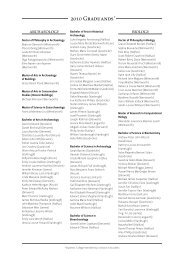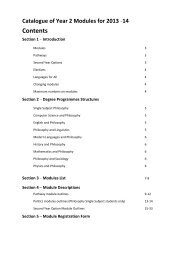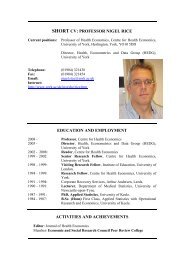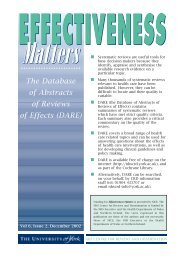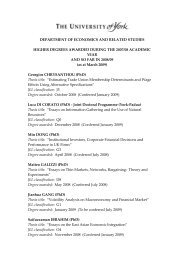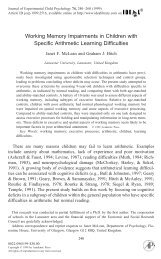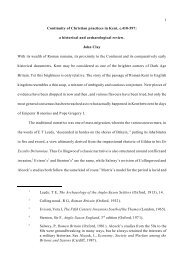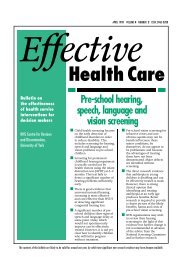Causal effects on employment after first birth - A ... - University of York
Causal effects on employment after first birth - A ... - University of York
Causal effects on employment after first birth - A ... - University of York
You also want an ePaper? Increase the reach of your titles
YUMPU automatically turns print PDFs into web optimized ePapers that Google loves.
for university graduates (17 m<strong>on</strong>ths or 27.7%).Figure 10 plots the ATT <strong>employment</strong> <str<strong>on</strong>g>effects</str<strong>on</strong>g> by two-year age groups, averaging treatmentc<strong>on</strong>troldifferences am<strong>on</strong>g <strong>first</strong>-time mothers in the age group. The estimated ATTs arealways negative and show similar patterns as before averaging over the age range 24 to33 years. Note that this similarity holds although older women work show higher <strong>employment</strong>rates than younger <strong>on</strong>es in both the treatment and the c<strong>on</strong>trol group - thesedifferences simply cancel out in the estimati<strong>on</strong> <strong>of</strong> the ATTs. Two years <strong>after</strong> child<strong>birth</strong>,the <strong>employment</strong> <str<strong>on</strong>g>effects</str<strong>on</strong>g> for the different age groups start to diverge with the oldest agegroup showing the str<strong>on</strong>gest negative <strong>employment</strong> <str<strong>on</strong>g>effects</str<strong>on</strong>g> and the youngest age groupshowing ATTs getting closest to zero five years <strong>after</strong> <strong>birth</strong>. This could be due to thefact that the average age at <strong>first</strong> child<strong>birth</strong> is about 28 years, which probably affects thebehavior <strong>of</strong> the c<strong>on</strong>trol group three to four years <strong>after</strong> treatment start for the treatmentgroup at age 24 and 25. The differences between the groups <strong>of</strong> 26–27, 28–29, and 30–31year-olds are negligible. At the same time, the absolute value <strong>of</strong> the ATT is very largefor the oldest c<strong>on</strong>sidered group.Am<strong>on</strong>g the results obtained so far, the large negative <strong>employment</strong> <str<strong>on</strong>g>effects</str<strong>on</strong>g> for the group<strong>of</strong> 32–33 year-olds stands out. This c<strong>on</strong>tradicts predicti<strong>on</strong>s derived from human capitaltheory saying that the ATT should be lower for older <strong>first</strong>-time mothers as they havealready acquired a high level <strong>of</strong> human capital through work experience. This groupdisplays a very high labor force attachment before <strong>birth</strong> and is <strong>of</strong> great relevance topolicy-makers. In fact, the 2001 and the 2007 reforms attempt to increase <strong>employment</strong>rates <strong>after</strong> child<strong>birth</strong> for previously employed women.Furthermore, our results are not in accordance with the hypothesis that delayed child<strong>birth</strong>leads to higher <strong>employment</strong>, which some <strong>of</strong> the literature finds evidence for (Troskeand Voicu, 2011; Herr, 2007; Miller, 2011). However, <strong>on</strong>e has to recall at this point thatwe estimate a different parameter than the literature. Troske and Voicu (2011) estimatethe effect <strong>of</strong> having a child versus not having a child where not having a child does notentail the possibility to have a child in the future. Given that a larger share <strong>of</strong> women inthe c<strong>on</strong>trol group have a child in the near future for <strong>birth</strong>s and that this share is fallingwith age (Figure 11), we would expect a disproporti<strong>on</strong>ately higher <strong>employment</strong> rate inour c<strong>on</strong>trol group at higher age compared to Troske and Voicu (2011) rati<strong>on</strong>alizing thestr<strong>on</strong>ger negative <strong>employment</strong> effect at older age in our case. In c<strong>on</strong>trast, Herr (2007) andMiller (2011) provide IV-estimate which <strong>on</strong>ly c<strong>on</strong>trast mothers at different age when thechild was born, i.e. in their approach the c<strong>on</strong>trol group effectively used does not involvewomen who do not have a child. Based <strong>on</strong> the same argument as above, <strong>on</strong>e would alsoexpect that our results show a str<strong>on</strong>ger negative <strong>employment</strong> effect at higher age <strong>of</strong> <strong>birth</strong>18



